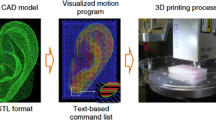Abstract
We propose a new variant of tissue P systems, with oriented division rules and external inputs. The oriented division rules are based on Hilbert’s space filling curve, more precisely on a new variant of parallel array rewriting rules, which generate Hilbert words of different ’resolutions’ in array representation. The P systems introduced here have also the capability to receive input from an external source. This is illustrated with a simple problem, that of approximating the contour of a 2D picture.





Similar content being viewed by others
References
Ahmed, M., & Bokhari, S. (2007). Mapping with space filling surfaces. IEEE Transactions on Parallel and Distributed Systems, 18(9), 1258–1269. https://doi.org/10.1109/TPDS.2007.1049.
Alhazov, A. (2006). Number of protons/bi-stable catalysts and membranes in P systems. time-freeness. In R. Freund, Gh. Păun, G. Rozenberg, & A. Salomaa (Eds.), Membrane computing (pp. 79–95). Berlin: Springer.
Aluru, S., & Sevilgen, F.E. (1997). Parallel domain decomposition and load balancing using space-filling curves. In: Proceedings fourth international conference on high-performance computing, pp. 230–235. https://doi.org/10.1109/HIPC.1997.634498.
Bader, M. (2012). Space-filling curves: an introduction with applications in scientific computing. Berlin: Incorporated: Springer Publishing Company.
Ceterchi, R., Mutyam, M., Păun, Gh., & Subramanian, K. G. (2003). Array-rewriting P systems. Natural Computing: An International Journal, 2(3), 229–249. https://doi.org/10.1023/A:1025497107681.
Ceterchi, R., Orellana-Martín, D., & Zhang, G. Contour approximation with P systems. In: Proceedings of the eighteenth brainstorming week on membrane computing, pp. 49–62. Sevilla, Spain
Ceterchi, R., & Subramanian, K.G. (2020). Generating pictures in string representation with P systems: The case of space-filling curves. Journal of Membrane Computing, 2, 369–379. https://doi.org/10.1007/s41965-020-00061-z.
Ceterchi, R., Zhang, L., Pan, L., Subramanian, K.G., & Zhang, G. Generating hilbert words in array representation with P systems. In: Pre-proceedings of the eighth Asian conference on membrane computing (ACMC2019), pp. 437–448. Xiamen, China.
Ciobanu, G., Pérez-Jiménez, M. J., & Păun, Gh. (2005). Applications of membrane computing (natural computing series). Berlin: Springer.
Cole, A. J. (1987). Compaction techniques for raster scan graphics using space-filling curves. The Computer Journal, 30(1), 87–92. https://doi.org/10.1093/comjnl/30.1.87.
Freund, R., Kari, L., Oswald, M., & Sosík, P. (2005). Computationally universal P systems without priorities: two catalysts are sufficient. Theoretical Computer Science, 330(2), 251–266. https://doi.org/10.1016/j.tcs.2004.06.029.
Frisco, P., Gheorghe, M., & Pérez-Jiménez, M. J. (2014). Applications of membrane computing in systems and synthetic biology. Complexity and computation series: emergence. Berlin: Springer.
Hilbert, D. (1891). Über die stetige Abbildung einer Linie auf ein Flächenstück. Mathematische Annalen, 38, 459–460.
Ibarra, O. H., Dang, Z., & Egecioglu, O. (2004). Catalytic P systems, semilinear sets, and vector addition systems. Theoretical Computer Science, 312(2), 379–399. https://doi.org/10.1016/j.tcs.2003.10.028.
Ionescu, M., & Sburlan, D. (2004). On P systems with promoters/inhibitors. Journal of Universal Computer Science, 10(5), 581–599.
Krishna, S. N., & Păun, A. (2004). Results on catalytic and evolution-communication P systems. New Generation Computing, 22(4), 377–394. https://doi.org/10.1007/BF03037288.
Kurc, T., Catalyurek, U., Chang, Chialin, Sussman, A., & Saltz, J. (2001). Visualization of large data sets with the active data repository. IEEE Computer Graphics and Applications, 21(4), 24–33. https://doi.org/10.1109/38.933521.
Lawder, J. K. (2000). Calculation of mappings between one and n-dimensional values using the Hilbert space-filling curve. London: School of Computer Science and Information Systems, Birkbeck College, University of London, London Research Report BBKCS-00-01 August.
Maurer, H., Rozenberg, G., & Welzl, E. (1982). Using string languages to describe picture languages. Information and Control, 54(3), 155–185. https://doi.org/10.1016/S0019-9958(82)80020-X.
Patil, S., Das, S.R., & Nasipuri, A. (2004). Serial data fusion using space-filling curves in wireless sensor networks. In: 2004 First Annual IEEE Communications Society Conference on Sensor and Ad Hoc Communications and Networks, 2004. IEEE SECON 2004., (pp. 182–190). https://doi.org/10.1109/SAHCN.2004.1381916.
Peano: (1890). Sur une courbe, qui remplit toute une aire plane. Mathematische Annalen, 36, 157–160.
Pilkington, J. R., & Baden, S. B. (1996). Dynamic partitioning of non-uniform structured workloads with spacefilling curves. IEEE Transactions on Parallel and Distributed Systems, 7(3), 288–300. https://doi.org/10.1109/71.491582.
Platzman, L. K., & Bartholdi, J. J. (1989). Spacefilling curves and the planar travelling salesman problem. Journal of ACM, 36(4), 719–737. https://doi.org/10.1145/76359.76361.
Păun, Gh. (2000). Computing with membranes. Journal of Computer and System Sciences, 61(1), 108–143. https://doi.org/10.1006/jcss.1999.1693.
Quweider, M., & Salari, E. (1995). Use of space filling curves in fast encoding of vq images. In: Proceedings, international conference on image processing, vol. 3, (pp. 101–104). https://doi.org/10.1109/ICIP.1995.537590.
Sagan, H. (1994). Space-filling curves. Berlin: Springer.
Siromoney, R., & Subramanian, K. G. (1983). Space-filling curves and infinite graphs. In H. Ehrig, M. Nagl, & G. Rozenberg (Eds.), Graph-grammars and their application to computer science (pp. 380–391). Berlin: Springer.
Skubalska-Rafajlowicz, E., & Krzyzak, A. (1996). Fast k-nn classification rule using metric on space-filling curves. In: Proceedings of 13th international conference on pattern recognition, vol. 2 (pp. 121–125). https://doi.org/10.1109/ICPR.1996.546736.
Valencia-Cabrera, L., Pérez-Hurtado, I., & Martínez-del Amor, M. A. (2020). Simulation challenges in membrane computing. Journal of Membrane Computing, 2, 392–402.
Zhang, G., Pérez-Jiménez, M. J., & Gheorghe, M. (2018). Real-life applications with membrane computing (1st ed.). Berlin: Incorporated: Springer Publishing Company.
PMCGPU project website: https://sourceforge.net/projects/pmcgpu/. Accessed 29 Sep 2020.
Acknowledgements
This work was supported in part by the research project TIN2017-89842-P, cofinanced by Ministerio de Economía, Industria y Competitividad (MINECO) of Spain, through the Agencia Estatal de Investigación (AEI), and by Fondo Europeo de Desarrollo Regional (FEDER) of the European Union. It was also partially supported by the National Natural Science Foundation of China, under Grants 61672437, 61972324 and 61702428.
Author information
Authors and Affiliations
Corresponding author
Ethics declarations
Conflict of interest
On behalf of all authors, the corresponding author states that there is no conflict of interest.
Additional information
Publisher's Note
Springer Nature remains neutral with regard to jurisdictional claims in published maps and institutional affiliations.
Rights and permissions
About this article
Cite this article
Ceterchi, R., Orellana-Martín, D. & Zhang, G. Division rules for tissue P systems inspired by space filling curves. J Membr Comput 3, 105–115 (2021). https://doi.org/10.1007/s41965-021-00071-5
Received:
Accepted:
Published:
Issue Date:
DOI: https://doi.org/10.1007/s41965-021-00071-5




